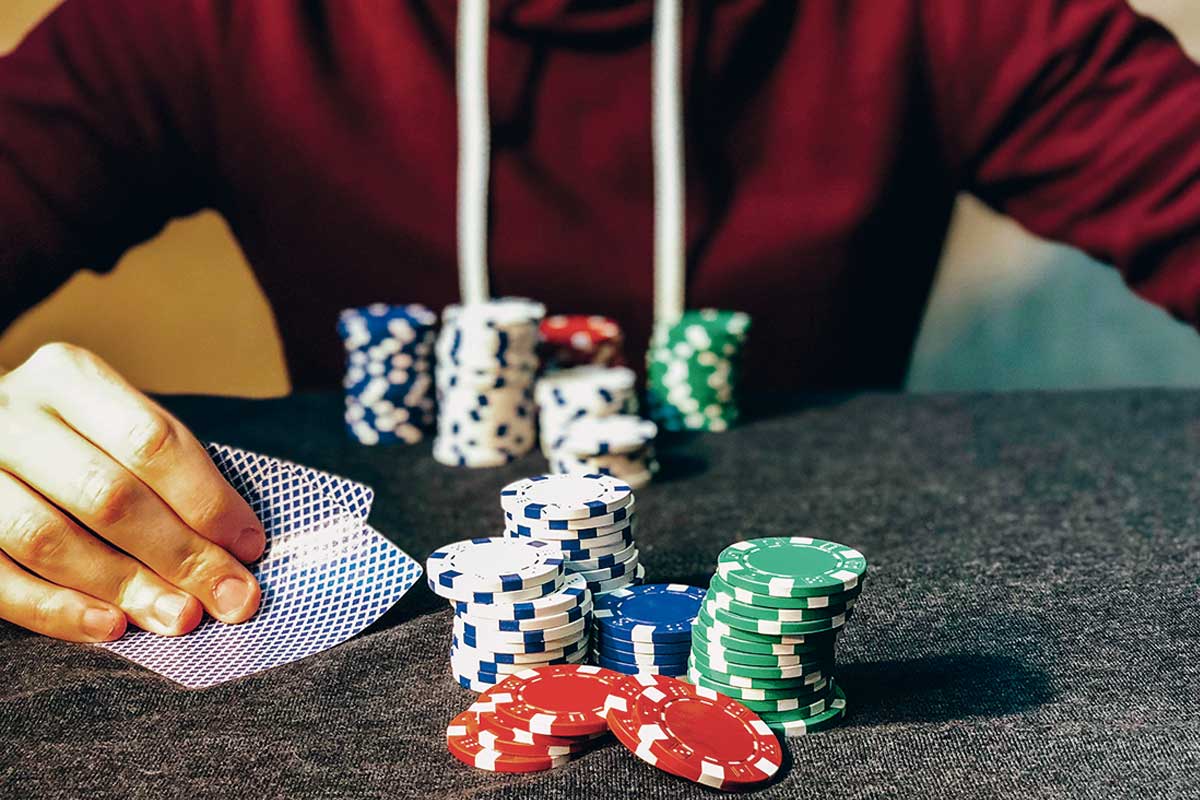Gambling addiction: myth or reality?
Analysing the scientific evidence on gambling disorder

Interest in gambling disorder, formerly known as pathological gambling, has been growing in both the clinical and scientific community. The increase in empirical evidence concerning gambling disorder has permitted a better understanding of the pathology, as well as the identification of common comorbidities and the design of potential therapeutic options. The present review addresses all these issues, including recent findings in this area of study.
Keywords: gambling disorder, behavioural addiction, mental disorder, epidemiology, aetiology, treatment.
What is gambling disorder?
Gambling involves risking money with the expectation of winning a larger amount. Some common forms of gambling include the lottery, electronic gambling machines (also known as slot machines), poker, and sports betting. For years, bars, gaming halls, and casinos where the most common gambling locations in Spain, but in recent years, online gambling has taken centre stage, to the detriment of land-based gambling. While the total amount gambled online in Spain in 2015 was 8,562.1 million euros, in 2020 it went up to 21,600 million, thereby representing a very significant increase of online gambling (Dirección General de Ordenación del Juego, [DGOJ], 2020).
Most individuals participate in gambling behaviour without it becoming problematic. However, some individuals lose control over these behaviours, which then interfere with many areas of their lives, including their health, personal relationships, academic and professional activities, and of course, their financial situation (American Psychiatric Association [APA], 2013).
The latest update of the Diagnostic and Statistical Manual of Mental Disorders (DSM-5; APA, 2013) uses the term gambling disorder to designate a persistent and recurrent gambling pattern that causes impairment and distress to the individual (previous versions of the DSM called it pathological gambling). In addition to the naming change, one of the most relevant modifications to the DSM-5 was the inclusion of this disorder in the «substance-related and addictive disorders» section, thus making it the first formally recognised behavioural addiction. This was because a growing corpus of empirical evidence had identified the characteristics typical of substance use disorders in gambling disorder, such as tolerance (a progressive need to place higher bets and gamble more frequently) and withdrawal syndrome (nervousness and irritability when interrupting gambling behaviour). This was a substantial modification because gambling disorder had previously been classified alongside impulse control disorders like pyromania, kleptomania, or intermittent explosive disorder (Jiménez-Murcia, Granero, Fernández-Aranda, Sauvaget et al., 2019).
Another relevant factor when considering gambling disorder is differentiating between game types. On the one hand, there are purely random games (such as the lottery or roulette) where the player is passive and must wait for the result, while others do require some skill or strategy (like poker, where some level of command over the rules is assumed). On the other hand, games can be classified based on whether the prize is immediate (e.g., slot machines) or delayed (the lottery). In addition, the addictive potential is higher when the prize is immediate or when the player perceives skill as a crucial aspect of the game (Blaszczynski & Nower, 2002). Another way to classify games is according to their channel, i.e., online or land-based (offline) games.
Epidemiology
The prevalence figures for gambling disorder are very heterogeneous because gambling is not equally available and popular in every country. In the specific case of Spain, the data shows that 0.9 % of the population develops this type of disorder over the course of their lifetime while 4.4 % of Spanish citizens relate to problem gambling behaviours (DGOJ, 2015).
Gambling behaviour usually starts during adolescence and plays a function in socialisation. While the disorder is more prevalent among young people, a significant number of elderly people also show gambling problems (Menchon et al., 2018).

In addition, gambling disorder affects men more often than women. Indeed, several epidemiological studies, both in the general population and in clinical contexts, have suggested that men are two or three times more likely to develop this type of disorder than women. However, it is possible that because of the social stigma associated with gambling, women might tend to hide their problem behaviours and thus, be underrepresented in prevalence studies (Kaufman et al., 2017).
There are also gender differences in terms of the type of game people choose to engage in: women are more likely to participate in non-strategic games (like slot machines or bingo) and to use gambling to regulate their negative emotional states (Hing et al., 2016). Likewise, the time patterns described for the evolution of this disorder also differ between the sexes. While men tend to start gambling at a younger age and take more years to develop problem gambling behaviours, women tend to start gambling at a later age. However, the time elapsing from the moment they start playing for leisure and the moment they experience problems is usually much shorter. This phenomenon is known as the telescoping effect (Grant et al., 2012). Player-specific profiles and features have also been described, depending on whether participants prefer online or land-based venues. Of note, online gamblers are usually younger, have a higher educational level and purchasing power, and present more expensive betting patterns than land-based gamblers (Jiménez-Murcia, Granero, Fernández-Aranda, Stinchfield et al., 2019).
Risk and protection factors
A variety of factors have been identified that could increase the chance of developing gambling-related problems.
Individual factors
Dowling et al. (2017) conducted a systematic review and identified a number of individual risk factors, including frequency of alcohol and tobacco use, illegal drug use, antisocial behaviour, depression, male gender, number of problem games, disorder severity, violence, and emotional regulation deficits.
However, although young people have traditionally been considered to be at a greater risk of developing problem gambling behaviour, research interest has more recently shifted to study the elderly population. In this sense, a major motivation for resorting to gambling is limited access to other reinforcing activities. These factors, together with stable incomes and limited prospects of future earnings make older adults an extremely vulnerable group (Granero, Jiménez-Murcia et al., 2020). Certain individual characteristics, such as socio-economic status and education level, have been identified as protective factors.
Certain personality traits could also be considered risk factors for the development or continuance of gambling disorder. Specifically, high harm avoidance (or neuroticism) together with low levels of self-direction and difficulties in decision-making and planning, as well as high impulsivity and sensation seeking (Jiménez-Murcia et al., 2015).
In fact, the literature suggests that this disorder is a heterogeneous condition. However, several aspects of impulsivity related to motor inhibition, attentional disturbances, or choice impulsivity seem to be common clinical features of the pathology (Ioannidis et al., 2019). Impulsivity could therefore be interpreted as an independent cognitive function that is altered in gambling disorder and which corresponds to different biological substrates within the frontostriatal circuitry (Ioannidis et al., 2019). Another interpretation would be latent phenotypical impulsivity, i.e., a general tendency to take hasty, inappropriate, and premature actions could predispose individuals to developing the disorder (Ioannidis et al., 2019).
Blaszczynski and Nower’s (2002) well-known pathway model suggests that three distinct groups are predisposed to problem gambling, these being behaviourally conditioned, emotionally vulnerable, and antisocial-impulsive individuals. Gambling-related motivations may differ between these groups; for example, behaviourally conditioned individuals would gamble due to a distortion in their perceived probability of winning and bad decisions; emotionally vulnerable individuals would use gambling behaviour as negative reinforcement to escape negative moods, and individuals with an impulsive-antisocial profile would use gambling as a tool for positive reinforcement. Subsequent studies with clinical and community populations have confirmed that this explanatory model is indeed useful (Jiménez-Murcia, Granero, Fernández-Aranda, Stinchfield, et al., 2019).
Social and environmental factors
Relational risk factors such as antisocial behaviour among peers, on the one hand, and community risk factors such as low academic achievement, on the other, have also been identified. Furthermore, parental supervision, religious beliefs, and spirituality are considered protective factors (Dowling et al., 2017).
Contrary to expectations, social relational problems have also been identified as a protective factor in the subsequent development of problem gambling, suggesting that young people who are good at establishing social relationships are at a higher risk (Yücel et al., 2015) because socialising may be a pathway for the development of problem gambling.
Neurobiological factors
The relative paucity of studies in the field of neuroimaging and genetics and the lack of translational research in animal and human models make it difficult to understand the neurobiology of gambling disorder.
However, the «Interaction of Person-Affect-Cognition-Execution» (I-PACE; Brand et al., 2019) model provides a comprehensive theoretical framework for understanding and investigating the development and maintenance of addictive behaviours as the result of interactions between individuals. This includes their specific characteristics (personality, genetics, psychopathology, specific motivations, etc.), and specific reactions to certain situational factors such as affective and cognitive responses to situations and behavioural cues. From this point of view, some authors have suggested that dysfunction in regions related to executive control, reward, action propensity, and the habit network may underlie this addiction in situations where stimulus responsiveness and inhibitory control are present in different types of non-substance behavioural addictions (Antons et al., 2020).

Studies that have examined the involvement of neurotransmitters in the development and maintenance of this type of addiction suggest potential contributions from serotonin, opioids, and the dopaminergic system. Indeed, the latter is implicated to a greater extent in non-substance behavioural addictions among people with Parkinson’s disease. However, complex interactions between neurotransmitter systems and neural networks may interact differently with the stages of addiction (Antons et al., 2020).
Moreover, it has been suggested that certain genetic factors may be involved in gambling disorder, especially in view of high rates of familial transmission and the effectiveness of opioid antagonists and partial agonists in the treatment of gambling and substance use disorders. Likewise, similarities have been found between substance use disorder and gambling disorder in terms of genetic vulnerability, biological markers, and cognitive deficits (Rash et al., 2016), which indicates the existence of a shared neurobiological substrate between the two disorders. On the other hand, the insula is also involved in the desire to gamble and has been proposed as a neurobiological target in gambling disorder interventions (Limbrick-Oldfield et al., 2017).
Clinical symptomatology
Gambling disorder is associated with several very specific clinical characteristics. On the one hand, individuals with this disorder may exhibit restlessness and irritability when trying to reduce or terminate gambling behaviour, with repeated failed attempts, a preoccupation with gambling (reliving past gambling experiences, planning the next bet, or thinking about how to get money to gamble) and, often with anxiety-driven gambling behaviours (guilt and helplessness, etc.). On the other hand, problem gamblers have also been reported to return to gambling after losing money (to recoup their losses); lie to hide the extent of their involvement in gambling; put their work, personal, or family relationships at risk; be financially dependent on others to alleviate desperate economic hardship caused by gambling; or commit illegal acts as a consequence of gambling. Although this latter characteristic is no longer included among the DSM-5 diagnostic criteria (APA, 2013), studies suggest that 25 % of patients with this disorder have committed illegal acts as a consequence of their gambling problems (Mestre-Bach et al., 2018) and this clinical feature is also associated with the severity of the disorder.
In addition, gambling disorder may be associated with specific psychological factors such as cognitive distortions (Granero, Fernández-Aranda, et al., 2020), the most common of which are erroneous beliefs, i.e., thinking that past events affect random future events (the gambler’s fallacy). Others are related to perceiving losses as being a step closer to a win or feeling that one may be able to control events over which one has no control (illusion of control). A recent multicentre trial conducted with 512 patients over the age of 18 connected to public care facilities or gamblers’ associations in Spain showed that cognitive distortions both in men (n = 473) and women (n = 39) were one of the factors most strongly associated with the severity of the disorder (Jiménez-Murcia et al., 2020).
Mood and substance-use disorders are the most common co-morbidities. Although less prevalent, other observed comorbidities included attention deficit hyperactivity disorder and other behavioural addictions such as problematic video game use or compulsive shopping (Ford & Hakansson, 2020). In addition, people with gambling disorder were at a higher risk of suicidal behaviour than the general population. More specifically, it was estimated that half of in-treatment individuals presented suicidal ideation and around 17 % had already made a suicide attempt (APA, 2013).
Response to treatment
Gambling disorder can be successfully treated (Jiménez-Murcia, Granero, Fernández-Aranda, Aymamí, et al., 2019) with different therapeutic options. At the psychological level, the most impactful interventions are cognitive therapies and cognitive-behavioural therapy, sometimes combined with other approaches such as motivational therapies or third-generation therapies such as mindfulness (Sancho et al., 2018). Cognitive therapies focus on modifying the cognitive distortions inherent to the disorder, especially those associated with the concept of chance (Ledgerwood et al., 2020). In contrast, cognitive-behavioural therapy integrates cognitive therapy and behavioural interventions to identify the external factors that trigger gambling behaviour and enhance alternative behaviours to cope with them (Jiménez-Murcia, Granero, Fernández-Aranda, Aymamí et al., 2019). Finally, motivational interventions focus on improving participation in treatment for people with gambling disorder and addressing any potential ambivalence they may experience.
In terms of pharmacological options, three possible alternatives have been suggested depending on their neuropharmacological target and the patient’s clinical characteristics. These are antidepressants, opioid antagonists (especially naltrexone), and mood stabilisers, although no conclusive results have yet been obtained for these treatments (Menchon et al., 2018).
In addition, it seems that not all therapeutic options are equally effective: while cognitive behavioural therapy seems to be most effective, the efficacy of pharmacotherapy seems to be lower, especially in the long term. Therefore, further study of both types of interventions and their possible combinations will be required to provide tailor-made treatments for each patient. Furthermore, treatments should be adapted to consider the evolution of different types of gambling, for instance, the significant recent expansion in online gambling.
When analysing the effectiveness of different treatments, we must also keep in mind that the concept of treatment response has not yet been well defined and its evaluation has been inconsistent. There is still also no agreement on what recovering from the disorder entails: some authors advocate complete abstinence from all forms of gambling but others consider the central therapeutic goal is control over gambling behaviour without the need to completely eliminate it. Thus, the lack of consensus makes it difficult to reach clear conclusions.
Pickering et al. (2018) recently published a systematic review of the response to treatment in gambling disorder. These authors considered all three essential evaluation domains. First, they considered any factors associated with gambling behaviour (e.g., frequency of gambling and associated monthly financial losses). The second area concerned the negative consequences of gambling behaviour, especially on the patient’s own health and interpersonal relationships, as well as potential legal consequences. Thirdly, their evaluation of therapeutic change included aspects such as the reduction of cognitive distortions associated with this disorder.
Of note, this field of research has experienced significant developments, especially given more studies are now incorporating a wide range of domains, making it clear that the recovery construct is multidimensional. Therefore, analysis of response to treatment should consider not only the reduction of symptoms, but also aspects associated with the mental, physical, and social well-being of the patients.
However, most of the criteria used to assess patients’ recovery have been adapted from the substance-use setting and so, virtually none of them considered the financial situation or debt associated with gambling behaviour as a factor in recovery. These aspects are crucial because they would highlight potential deterioration associated with gambling and, in addition, are factors that would not disappear with abstinence.

Finally, it should be noted that only a limited number of people with gambling disorder seek treatment. In fact, it is currently thought that less than 15 % of people affected end up receiving it. This is due to multiple factors such as the limited availability of services or the lack of insurance coverage in many countries. However, this issue is also directly dependent on the characteristics of the healthcare system. In Spain, for example, there are specialised units that depend on the national healthcare system, as well as many associations of rehabilitated gamblers, most of which are affiliated with the Spanish Federation of Rehabilitated Gamblers (FEJAR). However, multidisciplinary efforts would be required to ensure that people suffering from this disorder have adequate access to the different therapeutic options available.
Conclusions
The study of gambling disorder is steadily increasing due to its growing global prevalence, which is closely related to the emergence of new forms of Internet-based gambling. It is also an important economic activity for both businesses and administrations and has become extremely popular among young people, especially sports betting, which is more socially accepted and carries less perceived risk. This situation concerns society in general and many studies have warned of this problem and have highlighted the need for stricter regulation and prevention policies. However, given the clinical heterogeneity of the disorder, as well as age, gender, and cultural differences, further studies will be needed to investigate possible phenotypes and effective therapeutic approaches. Nonetheless, after all the above, it is clear that gambling activity can become a serious disorder and a behavioural addiction and so, society as a whole is responsible for taking appropriate measures to prevent it and minimise the impact of its consequences.
References
American Psychiatric Association. (2013). Diagnostic and statistical manual of mental disorders (5th ed.). American Psychiatric Association.
Antons, S., Brand, M., & Potenza, M. N. (2020). Neurobiology of cue-reactivity, craving, and inhibitory control in non-substance addictive behaviors. Journal of the Neurological Sciences, 415, 116952. https://doi.org/10.1016/j.jns.2020.116952
Blaszczynski, A., & Nower, L. (2002). A pathways model of problem and pathological gambling. Addiction, 97(5), 487–499. https://doi.org/10.1046/j.1360-0443.2002.00015.x
Brand, M., Wegmann, E., Stark, R., Müller, A., Wölfling, K., Robbins, T. W., & Potenza, M. N. (2019). The Interaction of Person-Affect-Cognition-Execution (I- PACE) model for addictive behaviors: Update, generalization to addictive behaviors beyond internet-use disorders, and specification of the process character of addictive behaviors. Neuroscience and Biobehavioral Reviews, 104, 1–10. https://doi.org/10.1016/j.neubiorev.2019.06.032
Dirección General de Ordenación del Juego. (2015). Estudio sobre prevalencia, comportamiento y características de los usuarios de juegos de azar en España. Ministerio de Hacienda y Administraciones Públicas.
Dirección General de Ordenación del Juego. (2020). Informe anual. Mercado de juego online estatal. Ministerio de Hacienda y Administraciones Públicas. https://www.ordenacionjuego.es/es/mercado-juego-online-estatal
Dowling, N. A., Merkouris, S. S., Greenwood, C. J., Oldenhof, E., Toumbourou, J. W., & Youssef, G. J. (2017). Early risk and protective factors for problem gambling: A systematic review and meta-analysis of longitudinal studies. Clinical Psychology Review, 51, 109–124. https://doi.org/10.1016/j.cpr.2016.10.008
Ford, M., & Hakansson, A. (2020). Problem gambling, associations with comorbid health conditions, substance use, and behavioural addictions: Opportunities for pathways to treatment. PLoS ONE, 15(1), e0027644. https://doi.org/10.1371/journal.pone.0227644
Granero, R., Fernández-Aranda, F., Valero-Solís, S., Del Pino-Gutiérrez, A., Mestre- Bach, G., Baenas, I., Contaldo, S. F., Gómez-Peña, M., Aymamí, N., Moragas, L., Vintró, C., Mena-Moreno, T., Valenciano-Mendoza, E., Mora-Maltas, B., Menchón, J. M., & Jiménez-Murcia, S. (2020). The influence of chronological age on cognitive biases and impulsivity levels in male patients with gambling disorder. Journal of Behavioral Addictions, 9(2), 383–400. https://doi.org/10.1556/2006.2020.00028
Granero, R., Jiménez-Murcia, S., Del Pino-Gutiérrez, A., Mena-Moreno, T., Mestre- Bach, G., Gómez-Peña, M., Moragas, L., Aymamí, N., Giroux, I., Grall-Bronnec, M., Sauvaget, A., Codina, E., Vintró-Alcaraz, C., Lozano-Madrid, M., Camozzi, M., Agüera, Z., Martín-Romera, V., Sánchez-González, J., Casalé, G., … Fernández-Aranda, F. (2020). Gambling phenotypes in older adults. Journal of Gambling Studies, 36(3), 809–828. https://doi.org/10.1007/s10899-019-09922-4
Grant, J. E., Odlaug, B. L., & Mooney, M. E. (2012). Telescoping phenomenon in pathological gambling: Association with gender and comorbidities. Journal of Nervous and Mental Disease, 200(11), 996–998. https://doi.org/10.1097/NMD.0b013e3182718a4d
Hing, N., Russell, A., Tolchard, B., & Nower, L. (2016). Risk factors for gambling problems: An analysis by gender. Journal of Gambling Studies, 32(2), 511–534. https://doi.org/10.1007/s10899-015-9548-8
Ioannidis, K., Hook, R., Wickham, K., Grant, J. E., & Chamberlain, S. R. (2019). Impulsivity in gambling disorder and problem gambling: a meta-analysis. Neuropsychopharmacology, 44(8), 1354–1361. https://doi.org/10.1038/s41386-019-0393-9
Jiménez-Murcia, S., Granero, R., Fernández-Aranda, F., Arcelus, J., Aymamí, M. N., Gómez-Peña, M., Tárrega, S., Moragas, L., Del Pino-Gutiérrez, A., Sauchelli, S., Fagundo, A. B., Brewin, N., & Menchón, J. M. (2015). Predictors of outcome among pathological gamblers receiving cognitive behavioral group therapy. European Addiction Research, 21(4), 169–178. https://doi.org/10.1159/000369528
Jiménez-Murcia, S., Granero, R., Fernández-Aranda, F., Aymamí, N., Gómez-Peña, M., Mestre-Bach, G., Steward, T., Del Pino-Gutiérrez, A., Mena-Moreno, T., Vintró- Alcaraz, C., Agüera, Z., Sánchez-González, J., Moragas, L., Codina, E., & Menchón, J. M. (2019). Developmental trajectories of gambling severity after cognitive-behavioral therapy. European Psychiatry, 60, 28–40. https://doi.org/10.1016/j.eurpsy.2019.04.001
Jiménez-Murcia, S., Granero, R., Fernández-Aranda, F., Sauvaget, A., Fransson, A., Hakansson, A., Mestre-Bach, G., Steward, T., Stinchfield, R., Moragas, L., Aymamí, N., Gómez-Peña, M., Del Pino-Gutiérrez, A., Agüera, Z., Alcazar, M. B., Talón-Navarro, M. T., Fuentes, À. C., Codina, E., & Menchon, J. M. (2019). A comparison of DSM-IV-TR and DSM-5 diagnostic criteria for gambling disorder in a large clinical sample. Frontiers in Psychology, 10, 931. https://doi.org/10.3389/fpsyg.2019.00931
Jiménez-Murcia, S., Granero, R., Fernández-Aranda, F., Stinchfield, R., Tremblay, J., Steward, T., Mestre-Bach, G., Lozano-Madrid, M., Mena-Moreno, T., Mallorquí- Bagué, N., Perales, J. C., Navas, J. F., Soriano-Mas, C., Aymamí, N., Gómez-Peña, M., Agüera, Z., Del Pino-Gutiérrez, A., Martín-Romera, V., & Menchón, J. M. (2019). Phenotypes in gambling disorder using sociodemographic and clinical clustering analysis: An unidentified new subtype? Frontiers in Psychiatry, 10, 173. https://doi.org/10.3389/fpsyt.2019.00173
Jiménez-Murcia, S., Granero, R., Giménez, M., Del Pino-Gutiérrez, A., Mestre-Bach, G., Mena-Moreno, T., Moragas, L., Baño, M., Sánchez-González, J., De Gracia, M., Baenas-Soto, I., Contaldo, S. F., Valenciano-Mendoza, E., Mora-Maltas, B., López-González, H., Menchón, J. M., & Fernández-Aranda, F. (2020). Moderator effect of sex in the clustering of treatment-seeking patients with gambling problems. Neuropsychiatrie, 34(3), 116–129. https://doi.org/10.1007/s40211-020-00341-1
Kaufman, A., Jones Nielsen, J. D., & Bowden-Jones, H. (2017). Barriers to treatment for female problem gamblers: A UK perspective. Journal of Gambling Studies, 33(3), 975–991. https://doi.org/10.1007/s10899-016-9663-1
Ledgerwood, D. M., Dyshniku, F., McCarthy, J. E., Ostojic-Aitkens, D., Forfitt, J., & Rumble, S. C. (2020). Gambling-related cognitive distortions in residential treatment for gambling disorder. Journal of Gambling Studies, 36(2), 669–683. https://doi.org/10.1007/s10899-019-09895-4
Limbrick-Oldfield, E. H., Mick, I., Cocks, R. E., McGonigle, J., Sharman, S. P., Goldstone, A. P., Stokes, P. R. A., Waldman, A., Erritzoe, D., Bowden-Jones, H., Nutt, D., Lingford-Hughes, A., & Clark, L. (2017). Neural substrates of cue reactivity and craving in gambling disorder. Translational Psychiatry, 7(1), e992. https://doi.org/10.1038/tp.2016.256
Menchon, J. M., Mestre-Bach, G., Steward, T., Fernández-Aranda, F., & Jiménez- Murcia, S. (2018). An overview of gambling disorder: From treatment approaches to risk factors [version 1; referees: 2 approved]. In Wellcome Open Research, 7. https://doi.org/10.12688/f1000research.12784.1
Mestre-Bach, G., Steward, T., Granero, R., Fernández-Aranda, F., Talón-Navarro, M. T., Cuquerella, À., Del Pino-Gutiérrez, A., Aymamí, N., Gómez-Peña, M., Mallorquí-Bagué, N., Mena-Moreno, T., Vintró-Alcaraz, C., Baño, M., Moragas, L., Magaña, P., Menchón, J. M., & Jiménez-Murcia, S. (2018). Sociodemographic and psychopathological predictors of criminal behavior in women with gambling disorder. Addictive Behaviors, 80, 124–129. https://doi.org/10.1016/j.addbeh.2018.01.022
Pickering, D., Keen, B., Entwistle, G., & Blaszczynski, A. (2018). Measuring treatment outcomes in gambling disorders: A systematic review. Addiction, 113(3), 411–426. https://doi.org/10.1111/add.13968
Rash, C., Weinstock, J., & Van Patten, R. (2016). A review of gambling disorder and substance use disorders. Substance Abuse and Rehabilitation, 7, 3–13. https://doi.org/10.2147/sar.s83460
Sancho, M., de Gracia, M., Rodríguez, R. C., Mallorquí-Bagué, N., Sánchez-González, J., Trujols, J., Sánchez, I., Jiménez-Murcia, S., & Menchón, J. M. (2018). Mindfulness-based interventions for the treatment of substance and behavioral addictions: A systematic review. Frontiers in Psychiatry, 9, 95. https://doi.org/10.3389/fpsyt.2018.00095
Yücel, M., Whittle, S., Youssef, G. J., Kashyap, H., Simmons, J. G., Schwartz, O., Lubman, D. I., & Allen, N. B. (2015). The influence of sex, temperament, risk-taking and mental health on the emergence of gambling: A longitudinal study of young people. International Gambling Studies, 15(1), 108–123. https://doi.org/10.1080/14459795.2014.1000356





